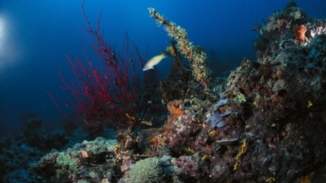
人造噪音影响海洋生物
Our Noise Bothers Overlooked Seafloor Critters
人造噪音影响海洋生物
Creatures that live on the seafloor play vital roles in marine ecosystems, but human-made noise can alter their behaviors.
生活在海底的生物在海洋生态系统中起着关键的作用,但人类制造的噪音会改变这些生物的行为。
播音/撰文 茱莉亚·罗森(Julia Rosen)
翻译 Meatle
审校 邰伦玥
Stick your head underwater and you’ll quickly discover that the ocean has a soundtrack. Waves crash, whales sing, and occasionally, an underwater earthquake rumbles from the depths. Over the last century, however, human activities have added to the din, with consequences for marine mammals and fish.
一头扎进水里,你会发现海洋里充满了声音。海浪声,鲸叫声,还有偶尔的海底地震带来的震动声。然而,在过去的一百年中,人类活动使海底更为喧闹,而后果则由海中的哺乳动物和鱼类承担。
Now, a team of researchers has investigated whether noise pollution also affects the behavior of critters that live on the seafloor. These animals might be small, but they play vital roles in marine ecosystems. For instance, they churn up ocean sediments and release nutrients that fuel the entire marine food web.
现在,一个研究团队调查了噪音污染是否同样地影响到海底小生物的活动。这些小动物可能很细小,但是对海洋生态环境起到重要的作用。例如,它们吃下海底的沉积物,并把其中的氮元素释放到海洋中,供养着整个海洋生物链。
“So in terms of their vulnerability to sound, they’ve been completely overlooked.” Martin Solan, a marine ecologist at the University of Southampton in England.
“然而,关于这些生物对噪音的抗性,我们缺乏研究。”英国南安普顿大学(University of Southampton)的海洋生态学家,马丁·索兰(Martin Solan)说。
Solan and his team tested the reactions of common bottom-dwelling creatures to sounds like the hum of ship engines and the clanking of underwater construction. Their test subjects were Manila clams, brittle stars, and lanky lobsters known as langoustines.
索兰和她的团队测试了通常海底生物对船的引擎的轰鸣声和海地建造的撞击声的反应。他们的测试对象有花蛤、海星和海鳌虾。
The researchers found that while the brittle stars seemed impervious to the racket, the other animals reacted strongly to certain human-made sounds.
研究人员发现海星对人造噪音无动于衷,但其他海洋动物都对某些人造噪音反应强烈。
“If you’ll excuse the pun, the clam kind of clammed up. It closed its valve and was pretty much stationary throughout the experiment. The lobster again stopped making its burrows and kind of cowered in the corner, and clearly wasn’t happy.”
“我不是故意要用双关,花蛤合上了(闭嘴了)(the clam kind of clammed up)。它们把贝壳合上,并在实验过程中保持‘沉默’。海鳌虾同样停下来了,为自己挖了个浅洞,就像卷缩在角落那样,显然并不高兴。”
The study is in the journal Scientific Reports. [Martin Solan et al, Anthropogenic sources of underwater sound can modify how sediment-dwelling invertebrates mediate ecosystem properties]
该研究发表在《科学报道》上(Scientific Reports)。
Solan ran the experiments for seven days. So he doesn’t know if the animals could have eventually gotten used to the noise. But he says the results are still concerning, because sound can travel great distances underwater, potentially affecting the behavior of entire populations of bottom-dwelling animals.
索兰的实验持续了7天。因此他不知道这些动物会否最终适应这些噪音。然而,他认为这个结论仍然存疑,因为声音在水中能够传播很远的距离,所以可能会影响到所有居住在水下的生物的行为。”
“If that behavior is important for controlling certain ecosystem processes, like for instance nutrient cycling, it’s then reasonable to suggest that fundamental aspects of the ecosystem may well change in ways that we currently don’t appreciate.”
“如果这些活动对于控制特定的生态过程起着关键作用,比如营养物质的循环,这些活动的改变可能会影响到生态系统的基础,并带来目前看来不太好影响。”
There might be ways to limit animals’ exposure to noise by absorbing or deflecting the underwater sounds. But Solan says that scientists first need to study how noise pollution reverberates through marine ecosystems, all the way down to the seafloor. In other words, how the hubbub permeates the glug-glug.
我们或许使用一些手段,比如通过吸收或反射的方式,去减少水下动物所承受的噪音。然而,索兰认为科学界应该去研究噪音如何长期影响海洋生物。换句话说,喧闹声是如何穿过水声的。
—Julia Rosen
未经书面许可任何人不得复制或镜像
京ICP备11000850号-1
 京公网安备11010502039775号
京公网安备11010502039775号 信息网络传播视听节目许可证0111611号
国家科技基础条件平台

















